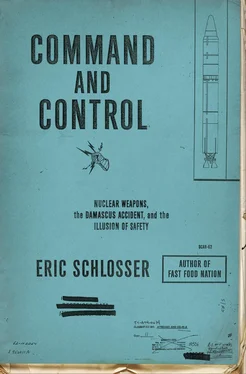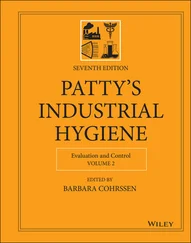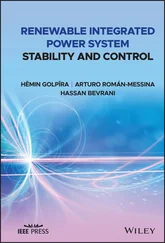For a moment Powell and Plumb just stood there, stunned, looking down at the fuel pouring out of the missile and the white mist floating upward, reaching level 6, level 5, level 4.
Oh, my God, Plumb thought, we’ve got to get the hell out of here.
Powell radioed the control center. There’s some kind of white, milky substance in the air at level 7, he said. And that’s all he said.
Captain Mazzaro told the PTS team chief, Charles Heineman, that his men should leave the silo immediately. Heineman ordered them to evacuate and return to the blast lock.
Powell motioned to Plumb: let’s go. The missile was now shrouded in fuel vapor, and the cloud was approaching the platform where they stood.
Mazzaro was puzzled. He wondered what this white substance could be. He thought about the maintenance that had been performed in the silo earlier in the day. What could the stuff be? He didn’t want to notify the command post at Little Rock Air Force Base until he had a better idea of what was happening. Mazzaro asked Heineman, who was sitting nearby, if he could think of anything.
The Klaxon went off, and the FUEL VAPOR LAUNCH DUCT light on the commander’s console began flashing red.
Powell and Plumb left the silo and closed the door. Powell wanted to take the elevator down to a lower level, look at the base of the missile, and assess the damage. But the team chief ordered him and Plumb to get out of the cableway and enter the blast lock, where the backup team was stationed. Roger Hamm and Gregory Lester opened blast door 9 for them, let them in, and then Lester quickly pulled it shut. They popped the helmets off their RFHCOs, as Hamm locked the door. Powell threw the wrench handle onto the floor and cursed.
Mazzaro turned off the Klaxon. The FUEL VAPOR LAUNCH DUCT light made no sense. Why would that come on, when the PTS crew was pressurizing the stage 2 oxidizer tank? He asked for vapor readings from the mine safety appliance, which were displayed on a panel in the blast lock. Three old-fashioned gauges there showed the vapor levels in the silo. Needles on the gauges moved to the right as the amount of vapor increased. The PTS team reported that the oxidizer level was ten parts per million — and the fuel vapor level was forty parts per million, almost the maximum reading. One of those gauges had to be wrong. There couldn’t be fuel vapors and oxidizer vapors in the silo at the same time; the two would have mixed and caused an explosion. Mazzaro wondered which gauge was correct. Then the needle on the fuel vapor gauge surged all the way to the right, and the MSA spiked.
The Klaxon went off again, and Al Childers looked up. He’d ignored it the first time, but now realized that something was wrong. He was sitting at a table behind the commander’s console, filling out paperwork that recommended his student, Miguel Serrano, for another alert. Suddenly the console was lit up like a Christmas tree. Rows of warning lights were flashing red. Then Childers heard somebody say there was a fire in the hole, got up from the table, grabbed a copy of the Dash-1, searched the manual for the fire checklist, found it, and started going through each step. Now the SPRAY lights were lit, which meant that the fire suppression system had been automatically triggered. Thousands of gallons of water were pouring into the launch duct. Childers pushed the SURFACE WARNING CONTROL button, turning on the red beacon topside, and contacted the PTS team up there.
Eric Ayala was in his RFHCO suit, standing near the nitrogen tank on the hardstand, when he heard over the radio that Powell and Plumb were backing out of the silo. Then he heard “fire in the hole” and Childers ordering everyone topside to evacuate the site. Ayala and his partner, Richard Willinghurst, quickly took off their RFHCOs. The third member of the team, David Aderhold, was sitting in a truck parked near the access portal, monitoring the radio. The truck held four extra RFHCOs, air packs, dewar units to refill them with air, and a portable shower. After hearing the order to evacuate, he helped Ayala and Willinghurst pack up their suits. Everyone jumped into the truck, leaving an empty pickup behind, and then Willinghurst drove toward the gate. A white cloud floated from the silo exhaust shaft, like smoke rising from a chimney.
Childers called the command post and said there was a fire in the silo. Mazzaro was already on the phone with Little Rock. Holder came down the stairs, noticed the commotion, and sat at the commander’s console. The warning lights didn’t make sense — FUEL VAPOR LAUNCH DUCT, OXI VAPOR LAUNCH DUCT, FIRE LAUNCH DUCT. One of those might be correct, but not all three at the same time. Holder decided to go through the checklists for a fuel leak, an oxidizer leak, a fire. One of the first steps for any propellant leak was to check the propellant tank pressure monitor unit (PTPMU), the digital readout on top of the console. It displayed the pressure levels in each of the missile’s four tanks. Holder pushed the buttons on the PTPMU and recorded the numbers in his log book. For some reason, the pressure in the stage 1 fuel tank seemed low.
It was 6:40 in the evening, about ten minutes after the first Klaxon had sounded. Ronald Fuller was going through all three checklists, too. He closed the blast valve — sealing the ventilation system, cutting off the control center from the air outdoors — and began to set up a portable vapor detector near blast door 8. It would warn if toxic fumes were seeping into the room.
The gate phone rang, and Childers answered it. The PTS crew topside wanted to leave the complex. Childers opened the gate for them and then returned to the fuel vapor checklist. He couldn’t understand why the purge fan in the silo wouldn’t go on. The purge fan was supposed to clear out any fuel vapors. He kept pushing the PURGE button but nothing happened. Then he remembered that if there was a fire, they didn’t want the fan to go on. It would pull fresh air into the silo and feed the fire.
“Can my people come back into the control center?” Heineman asked. Childers said yes. He’d thought it was useful to keep Powell, Plumb, and the others in the blast lock, monitoring the vapor levels on the panel. But then he remembered that the MSA automatically shut off whenever the sprays went on, so that water wouldn’t be sucked into the vapor sensors. Too many things seemed to be happening at once; it felt hard to stay on top of them all. Powell and Plumb entered the control center in their RFHCOs, Hamm and Lester in thermal underwear. In the rush to get out of the blast lock, the two had left their RFHCOs in boxes on the floor there. Blast door 8 was swiftly closed and locked. Heineman joined his men, and the group huddled near the door.
“There’s got to be a malfunction,” Childers said, three or four times. Too many warning lights were flashing at once. But even if it was a malfunction, the crew had to act as though the hazards were real. Childers asked Serrano if he’d ever plotted a toxic corridor on a map.
Serrano replied that he’d once taken a class on it.
“Well, get over here,” Childers said. “You’re going to watch me do it.”
With a map, a compass, a grease pencil, and a protractor, Childers started to plot on a map where a cloud of fuel, smoke, or oxidizer would travel outdoors. The wind speed was almost zero, good news for the nearby houses and farms but not for the crew. A toxic cloud would hover and swirl directly above the missile complex.
Captain Mazzaro was still on the phone to the command post, where a Missile Potential Hazard Team was being formed. At the direction of the wing commander, the officers and airmen on the base who knew the most about the Titan II were being recalled to duty: maintenance and operations supervisors, the chief of safety, the chief of missile engineers, an electrical engineer, a bioenvironmental engineer, a backup missile combat crew, among others. Security police were calling homes and searching classrooms to gather the team. And a Missile Potential Hazard Net was being established — a conference call linking the command post at Little Rock with experts at SAC headquarters in Omaha, the Ogden Air Logistics Center at Hill Air Force Base in Utah, and the headquarters of the Eighth Air Force at Barksdale Air Force Base in Louisiana. One of the command post’s first decisions was to send a Missile Alarm Response Team (MART) to the launch complex. A pair of security officers stationed at a nearby missile site grabbed their gas masks and hurried to Damascus.
Читать дальше












